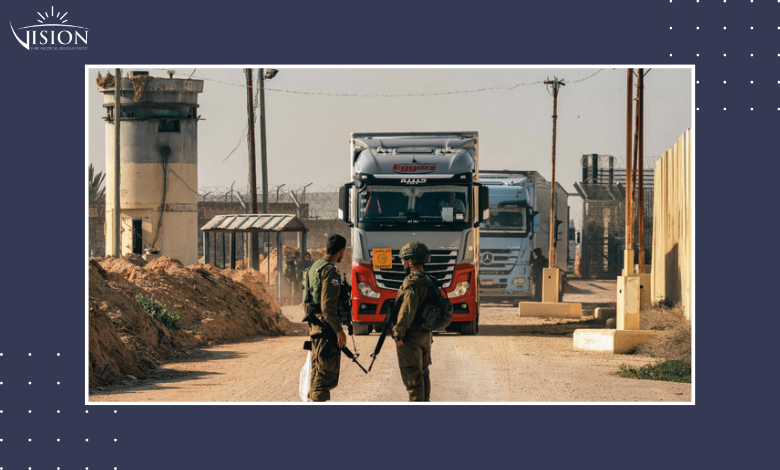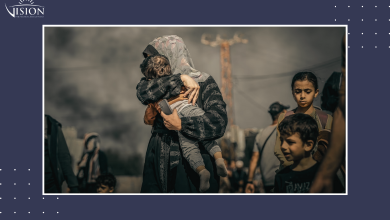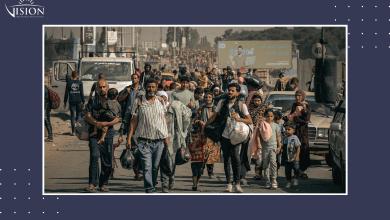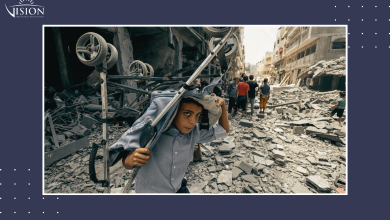Checkpoint Closures: A Horrific Chapter in the Genocide of Gaza
Hedaya Mohammed El Tatar

Since 2006, the Palestinian people in the Gaza Strip have endured a suffocating blockade imposed by the Israeli occupation, cutting them off from the world and severing their lifeline.
Following the victory of Hamas in the legislative elections of January 2006, the Israeli authorities adopted a policy of collective punishment against the civilian population. This policy intensified in June 2007, when Israel shut down all eight border crossings, effectively sealing off Gaza from the outside world. The blockade included a ban on the entry of goods, fuel, and the movement of people in and out of the Strip.
Since then, only four crossings have been reopened — and even then, only intermittently and under strict Israeli control. These are: Rafah and Beit Hanoun for the movement of individuals, and Kerem Shalom and the Salah al-Din Gate for commercial goods and fuel — all subject to severe restrictions dictated by the Israeli occupation.
Following the Israeli declaration of genocidal onslaught on the Gaza Strip on October 7, 2023, the occupation forces tightened their stranglehold by completely sealing off all crossings into Gaza, severing the only lifeline for the 2.4 million Palestinians residing in the enclave.
It wasn’t until January 19, 2025, that a ceasefire agreement was brokered between the Palestinian resistance movement Hamas and the Israeli occupation, with Egyptian and Qatari mediation and U.S. support. The agreement led to the reopening of the Kerem Shalom crossing for fuel and goods, and the Rafah crossing for the passage of the sick and injured.
However, just 39 days later, in early March 2025, Israel unilaterally reclosed the crossings, reneging on the terms of the ceasefire. This abrupt reversal plunged Gaza’s population back into catastrophic conditions — with severe shortages of food, medical supplies, and fuel — while humanitarian services provided by local institutions collapsed under the weight of the renewed blockade.
‘Manufactured’ Food Insecurity and the Collapse of Basic Life Systems
On March 2, 2025, the Israeli occupation forces escalated their siege by halting the entry of all goods and supplies and sealing all crossings into the Gaza Strip, following a decision by Israeli Prime Minister Benjamin Netanyahu. This move drastically worsened the already dire humanitarian crisis and pushed the civilian population deeper into deprivation and despair.
The consequences were immediate and devastating. Gaza, already on the brink after months of war and blockade, saw its humanitarian infrastructure pushed towards breaking point. The decision prompted urgent warnings from leading UN humanitarian agencies — including UNICEF, the Office for the Coordination of Humanitarian Affairs (OCHA), the World Health Organization (WHO), and the UN Relief and Works Agency for Palestine Refugees (UNRWA).
These organizations sounded the alarm over an imminent humanitarian collapse in Gaza, characterizing the situation as a complete disregard for human life. With food stocks dwindling, malnutrition on the rise, and medical supplies nearly depleted, the Strip teetered on the edge of famine — a catastrophe manufactured and maintained by policies of collective punishment.
In the wake of the genocide that the Israeli occupation has been perpetrating against the Palestinian people in Gaza for over a year and a half, the population has come to rely almost entirely on humanitarian aid for basic survival. This aid — the only source of food for many — is funnelled through the Rafah crossing on the Egyptian border and the Kerem Shalom crossing in the far southeast of the Strip.
Yet even this lifeline remains under the full control of the Israeli occupation, which dictates the quantity, type, timing, and destination of the aid allowed in. Shipments are only permitted entry following Israeli security clearance, thorough inspection, and coordination with the United Nations. Aid is primarily distributed through key international humanitarian agencies such as UNRWA, the World Food Programme (WFP), and the International Committee of the Red Cross.
The distribution process operates through three main organizational tiers. The first and most significant — covering over 85% of total aid — is managed by international and UN institutions in partnership with local NGOs. The second tier is overseen by the Ministry of Social Development in Gaza, which manages the remaining 15% of aid, based on a unified, computerized database that tracks needs across all regions of the Strip.[1]
The suspension of humanitarian aid deliveries has led to an acute shortage of essential food items, as existing supplies in Gaza have nearly run out. UNRWA’s food warehouses have been emptied of aid stocks, while what remains on the local market is sold at exorbitant prices — far beyond the reach of most residents.
This crisis is the direct result of the continued closure of border crossings and the Israeli occupation’s tight control over the types and quantities of goods and fuel allowed into the Strip. Such manipulation has created what experts describe as an economically distorted system, where the basic principles of supply and demand no longer apply.
When specific goods are permitted in large quantities, the market suffers from price crashes. Conversely, when other essential items are withheld, their scarcity drives prices up to unsustainable levels — pushing much of Gaza’s population into deeper poverty and placing the territory on the brink of famine, as supply routes dwindle and viable alternatives vanish.[2]
The collapse of food security in the Gaza Strip has already claimed the lives of more than 57 Palestinians, the vast majority of them children, due to dehydration and severe malnutrition. Over 3,500 children under the age of five are now facing the imminent threat of death, while more than 70,000 children have been hospitalized due to hunger-related complications.
An estimated 1.1 million children — nearly half of Gaza’s population — are currently deprived of the minimum daily food intake required for survival.
This crisis unfolds amid a total absence of food and the widespread shutdown of bakeries, which have ceased operations due to a lack of flour and energy supplies. On top of this, Palestinians in Gaza are being systematically denied even the most basic elements of human survival[3] — food, water, shelter, and medical care — in what can only be described as a deliberate dismantling of life.(Government Media Office, Press Release No. 789, April 2025)
The Israeli occupation has systematically starved the Palestinian people in Gaza by allowing only limited quantities of food, insufficient even for mere survival. In a previous interview on a French television channel, Israeli Prime Minister Benjamin Netanyahu stated that he is committed to ensuring every Palestinian in Gaza receives 3,200 calories per day.
However, leaked documents from the Israeli Ministry of Security reveal a far more chilling plan. The so-called “Red Lines” strategy, presented to the Israeli cabinet’s security subcommittee, is designed to monitor and tightly control food entry into Gaza, allowing only the minimum necessary to prevent outright famine — and nothing beyond that.
The plan estimates the daily caloric requirement per person in Gaza at 2,279 calories, a figure below the global minimum standard. By comparison, the UK’s National Health Service estimates that an average man needs 2,500 calories per day to maintain a healthy weight, while women require about 2,000 calories.
This approach has been firmly rejected by the United Nations. UN Secretary-General António Guterres stated unequivocally that the organization will not participate in any aid arrangements that violate the principles of humanity, integrity, independence, and neutrality. He warned that the Israeli authorities’ recently proposed mechanisms for authorizing aid deliveries risk unprecedented control and ruthless restrictions, squeezing every last calorie and grain of flour.
According to the Integrated Food Security Phase Classification (IPC) report, issued by 17 UN humanitarian agencies and international NGOs, 470,000 people in Gaza are expected to face catastrophic hunger (Phase 5, the most severe level of the classification) between May and September 2025 — representing a 250% increase over previous estimates.
The report states that the entire population is suffering from high levels of acute food insecurity. It also predicts that 71,000 children and more than 17,000 mothers will require urgent treatment for severe malnutrition.
The complete closure of the border crossings constitutes a crime against humanity and a blatant violation of international law and International humanitarian law, which explicitly prohibits the starvation of civilians. It also violates the Fourth Geneva Convention on the protection of civilians — particularly Articles 16 to 20 — which mandate the provision of relief, medical supplies, and clothing to civilian populations.
These legal protections are flagrantly disregarded by the Israeli occupation in Gaza, actions that the Rome Statute of the International Criminal Court classifies as acts of genocide.
Paralysis of Vital Sectors
After a month and a half of the strangulating siege on Gaza, the crises faced by the population have escalated sharply. Humanitarian services provided by local municipalities have sharply declined, and residents have plunged into severe thirst after being deprived of the minimum water necessary for survival. Water has effectively been weaponized — a slow, systematic form of mass killing.
The Israeli occupation has deliberately destroyed water stations and wells, including the Ghabayin desalination plant east of the Tuffah neighbourhood in Gaza City. Water pumping stations have also ceased operations due to severe fuel shortages and the cutting of electricity to the main desalination plant in Deir al-Balah in central Gaza.
This shutdown halted the daily supply of 20,000 cups of water to the Central and Khan Younis governorates. Additionally, the Israeli occupation disabled the two “Mekorot” water pipelines — Gaza’s primary water sources — exacerbating the crisis and causing a shortfall exceeding 70% of Gaza City’s water needs.
The closure of the crossings has also prevented desalination plants from purifying the groundwater extracted from beneath the earth, much of which has become contaminated with nitrates due to the occupation pumping sewage-contaminated seawater into tunnels, which then seeped into the groundwater supply.
Contaminated Water and Widespread Illness: A Man-Made Health Crisis
According to Ibrahim Samour, a technician at one of Gaza City’s water desalination plants, the lack of resources, equipment, and purification materials has forced residents to consume contaminated water laced with high levels of nitrates. The plants are unable to properly treat the water due to the absence of chlorine, dechlorinator, and anti-scalant chemicals, as well as the lack of functioning membrane filters (brine filters), which are currently being used despite having expired.
As a result, the vast majority of the population is drinking water unfit for human consumption — only partially desalinated, still carrying dangerous levels of microbial and nitrate contamination. [4]
This dire situation has led to over 1.7 million reported water-related illnesses, including widespread cases of diarrhoea, acute inflammatory intestinal diseases such as dysentery, and Hepatitis A (Government Media Office, Press Release No. 789, April 2025).
Amnesty International has described these practices as inhumane and unlawful, stating they are a clear indication that the Israeli occupation is deliberately subjecting Palestinians to living conditions intended to bring about their physical decline and annihilation. The organization condemned these acts as a violation of international humanitarian law and cited them as further evidence of the genocide being carried out by the Israeli occupation against the Palestinian population in the besieged Gaza Strip.
In yet another crime added to the series of systematic violations committed by the Israeli occupation against the Palestinian people in Gaza, Israel continues to block the entry of critical equipment needed to maintain vital infrastructure, as well as supplies of energy, fuel, and cooking gas essential for operating basic services and facilities.
This blockade has dramatically worsened the humanitarian, health, and environmental crisis. Thousands of tons of uncollected waste have accumulated in streets, public squares, near homes, and around displacement shelters. At the same time, sewage continues to flood roads and neighbourhoods as pumping stations — reliant on fuel and electricity — have shut down.
Adding to the danger, decomposing bodies remain trapped under the rubble, posing grave threats to public health and raising alarms of impending disease outbreaks and epidemics.
The accumulated waste in Gaza City has now reached 175,000 tons, while the length of sewage networks destroyed by the Israeli military has reached 175,000 linear meters — further exacerbating the suffering of civilians amid rapidly deteriorating environmental conditions.[5]
Beneath the Rubble: A Looming Epidemic Threat
Thousands of bodies remain trapped beneath the rubble of destroyed homes, posing an acute environmental and public health threat. These decomposing corpses risk becoming breeding grounds for contagious and infectious diseases, potentially leading to the outbreak of epidemics such as cholera.
This concern was confirmed by Civil Defense spokesperson Mahmoud Basal, who stated that rescue teams are working tirelessly to recover the bodies of martyrs from beneath the debris. However, their efforts are severely hindered by the lack of heavy equipment and specialized tools needed to remove the rubble and retrieve the remains.
As a result, more than 10,000 victims are still buried beneath the ruins of homes across the Gaza Strip — their recovery delayed, their presence endangering both the living and the environment[6].
Since the genocidal onslaught against Gaza, the Israeli military systematically destroyed nearly all of the equipment and resources belonging to the Civil Defense forces, rendering the agency completely incapacitated — with a 100% operational deficit.
Just two weeks ago, Israeli forces deliberately targeted and destroyed bulldozers that had been allowed into Gaza under the ceasefire agreement, equipment intended for the recovery of the dead and wounded. As a result, rescue crews are now forced to dig with their bare hands and primitive tools, while many bodies remain trapped beneath layers of concrete that the teams are physically unable to lift.
Collapse of the Health System
The repercussions of the border crossings closure around Gaza have gone far beyond, casting a dark shadow over the health sector, which is now witnessing a total collapse amid the ongoing Israeli aggression. Hospitals and medical centers continue to be targeted, while the entry of essential medicines and medical supplies remains blocked. This has exacerbated the already dire health and humanitarian crises facing the population, intensifying their daily suffering and creating catastrophic challenges to providing care for the sick and wounded.
According to Dr. Marwan Al-Hams, director of field hospitals in Gaza, the ongoing closure of the crossings will lead to a major tragedy due to the Israeli occupation’s stubborn refusal to allow the entry of medicines and medical supplies. Currently, hospitals are operating at only 25% to 30% of their capacity, with critical departments such as surgery, intensive care, and emergency running on nearly depleted stocks of life-saving drugs and essential medical equipment amid the continued genocidal war.[7]
According to an urgent appeal issued by the Ministry of Health to replenish drug stocks in hospitals and primary care centers, the shortage of medicines and medical consumables has reached critical and unprecedented levels. Currently, 37% of the essential medicines list is completely out of stock, along with 59% of medical consumables. Furthermore, 54% of cancer and haematology drugs are depleted, endangering patients’ lives and halting their treatment protocols. Additionally, 40% of primary care medications and 51% of maternal and child health medicines are unavailable, while 42% of paediatric vaccines are out of reach in Gaza. On top of this, the occupation continues to block the entry of polio vaccines, threatening to unravel seven months of efforts to control the epidemic. (Ministry of Health, April 7, 2025, press release).
Adding to the collapse of the healthcare system is the severe shortage of fuel and spare parts for medical devices, threatening the shutdown of critical hospital departments that rely on fuel-powered generators for electricity. Patients and injured individuals in Gaza are also deprived of diagnostic imaging services due to the destruction of CT scanners and MRI machines by the occupation. These devices cannot be repaired because the occupation prohibits the entry of spare parts necessary for their maintenance and reuse.
The Israeli occupation has not only wounded Gazans with internationally banned missiles and blocked the supply of their medications and painkillers, but it continues to inflict suffering by denying nearly 13,000 patients and injured people the chance for specialized treatment outside the Strip. This follows the re-closure of the Rafah border crossing on March 18, 2025. (Ministry of Health, April 2025, press statement).
Despite the urgent need for medical personnel—who have been exhausted after nearly a year and a half of continuous work treating the injured and wounded—the Israeli occupation has prevented hundreds of surgeons and medical delegations from entering. This has further exacerbated the suffering of the health sector, which is already under unprecedented pressure. (Government Media Office, March 2025, Press Statement No. 768).
Collapse of the Economic Sector
Border crossings serve as vital supply chains for any economic project and are key indicators of the success of trade in any country. According to the Paris Economic Protocol signed by the Palestinian Authority and the Israeli occupation on April 29, 1994, Israel exercises full control over the minutest details of Palestinian economic life through its absolute dominance and control over ports and crossings. Consequently, the Gaza Strip has been experiencing a total economic paralysis since the onset of the genocidal war a year and a half ago, continuing to this day, due to Israel’s complete closure of these crossings.
According to economic expert Ahmed Abu Qamar, the closure of Gaza’s border crossings has prevented the entry of trucks, which during the ceasefire period averaged between 200 and 400 trucks per day, whereas the sector requires between 800 and 1,000 trucks daily.
The closure of the crossings has also caused unemployment rates to soar to 85%, due to the halt of economic activity and the dismissal of thousands of workers from factories, agricultural, and livestock farms, after the Israeli occupation blocked the entry of any raw materials needed by the Gaza Strip.
Poverty rates have also surged, with approximately 90-95% of the population now dependent on humanitarian aid that used to arrive from outside Gaza in limited quantities but has completely stopped since Israel closed the crossings on March 2, 2025.[8]
What has further exacerbated the harsh living conditions for the people of Gaza is the astronomical rise in the prices of basic goods, as described by Sharif Samour from Sheikh Radwan neighbourhood in northern Gaza City. The price of a bag of flour has now exceeded $100, which is twelve times its previous price. Similarly, a kilogram of eggplant costs 50 shekels, compared to just 2 shekels before the war. This comes amid a complete absence of income, with no salaries or other means of livelihood available, intensifying the suffering of the population and pushing them toward a terrifying famine feared by everyone in Gaza.[9]
In conclusion,
The ongoing closure of the crossings by the Israeli occupation and the halt of humanitarian aid and medical supplies have severely worsened the humanitarian situation in Gaza. The daily suffering of Gazans has intensified due to multiple crises affecting their lives and future—ranging from famine that is ravaging children and the elderly who have lost access to basic food and clean water, to the paralysis of vital sectors. This paralysis has led to the spread of waste and sewage in streets and roads, causing epidemics and diseases to proliferate among the population with no access to treatment or medicine.
The closure of crossings has also resulted in the loss of dozens of patients and injured individuals who were denied access to treatment abroad, prevented specialized medical delegations and surgeons from entering Gaza, and blocked the entry of essential medicines and medical supplies. Moreover, the blockade has caused the collapse of environmental and health services, as well as the economic, transportation, and other key sectors—constituting a flagrant violation of all international treaties and laws. It is imperative for the international community to act by stopping this genocide, reopening the crossings, and allowing everything necessary for Palestinians to live with dignity in their land and homeland.
—————————————————————————————————————–
[1] Interview conducted by the researcher with Dr. Ismail Al-Thawabta, Director General of the Government Media Office (May 4, 2025).
[2] Interview conducted by the researcher with economic expert Ahmed Abu Qamar (April 20, 2025).
[3] Interview with Ismail Al-Thawabta, previously mentioned.
[4] Interview conducted by the researcher with Ibrahim Samour, technician at one of the water desalination plants (May 4, 2025).
[5] Interview conducted by the researcher with Issam Al-Nabeeh, spokesperson for Gaza Municipality (May 4, 2025).
[6] Interview conducted by the researcher with Mahmoud Basal, spokesperson for Civil Defense (May 4, 2025).
[7] Interview conducted by the researcher with Dr. Marwan Al-Hams, Director General of Field Hospitals in Gaza Strip (April 10, 2025).
[8] Interview conducted by the researcher with economic expert Ahmed Abu Qamar (April 20, 2025).
[9] Interview conducted by the researcher with citizen Sharif Samour (April 20, 2025).
NOTE: This text is adapted from original Arabic article.





